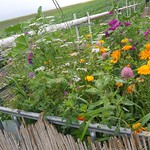
A Bio-inspired Multilayer Drainage System
About
A Solution Bio-inspired multilayer drainage system is being developed by Alchemia Nova (ALCN). It deals with agricultural run-off which transports a significant amount of nitrogen and phosphorus leached after fertilization period. Subsurface drainage pipes, also contribute to the direct transport of nutrients from subsurface drainage water into receiving waters, decreasing their quality and resulting in eutrophication. In order to address agricultural run-off issue, two experimental vertical flow filter systems have been installed by Alchemia Nova at the slope of an agricultural field in Mistelbach, Austria. Both filter systems contain biochar and other substrates that have adsorption properties of nutrients (Nitrogen, Phosphorus) and are designed according to the Austrian guideline for vertical flow wetlands ÖNORM 2505. A different and innovative setup, also containing biochar will be installed at Gleisdorf, Austria targeting nutrient removal from subsurface agricultural drainage water.
The main expected result is the nutrient removal efficiency from these different filter designs addressing agricultural surface run-off and subsurface drainage water. They will be re-applied, either by the removable biochar or by the plants produced by the vertical flow filter. The filter system can be of practical use if an excess of nutrients being washed out is of concern in the fields of the practitioner by keeping the surrounding waters clean. This approach may result in economic value, by re-using the saturated biochar as fertilizer as well as an improvement of the soil structure, thus increasing long-term soil fertility. The system is expected to be low maintenance apart from harvesting the plants yearly and changing the biochar when it is saturated with nutrients.
Case Study - Where We Test Our Solution
This Solution is tested at Austrian case study sites Mistelbach and Gleisdorf. Mistelbach is an organic farming field and Gleisdorf is both organic and conventional farming field. Partners involved in this solution are Alchemia Nova, Universität für Bodenkultur Wien, University of Oulu, Martin Regelsberger, Technical Research Centre of Finland Ltd.



Solution Test Progress
Mistelbach, Austria
At the case study location Mistelbach, solution is in the monitoring season now. Effluent volumes of the three systems, phosphate, nitrate, ammonia and pH are monitored. Also, influent and effluents sample is monitored every time there is a rain event.
- June 2021 – System installed;
- 2021 – No data from 2021 due to dry season and no runoff;
- April 2022 – September 2022 – monitoring season.
Gleisdorf, Austria
At the case study location Gleisdorf, Austria, the influent and effluent of drainage filter system is monitored. Parameters that are monitored are: pH, EC, phosphate, nitrate and ammonia.
- April 2022 – Prototype produced and installed;
- April 2022 – Now – monitoring is in progress.
Publications
- WATERAGRI Solution Test Findings, Project Deliverable
- Assessment of Biochar for Nutrient Retention, Practice Abstract
- Development of a Bio-inspired Drainage System to Improve Irrigation Practices and Nutrient Retention, Practice Abstract
- Canga, J. Hartmann, I. Kantauer, J. Kisser. A Bio-inspired Multi-layer Drainage System for Agricultural Surface Runoff and Subsurface Drainage Pipes, Poster published at 5th WATERAGRI General Assembly





